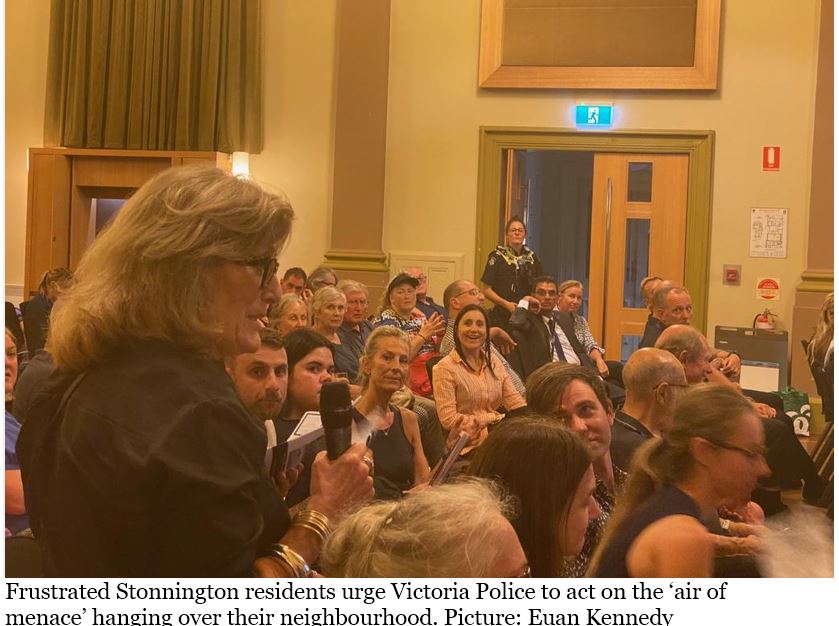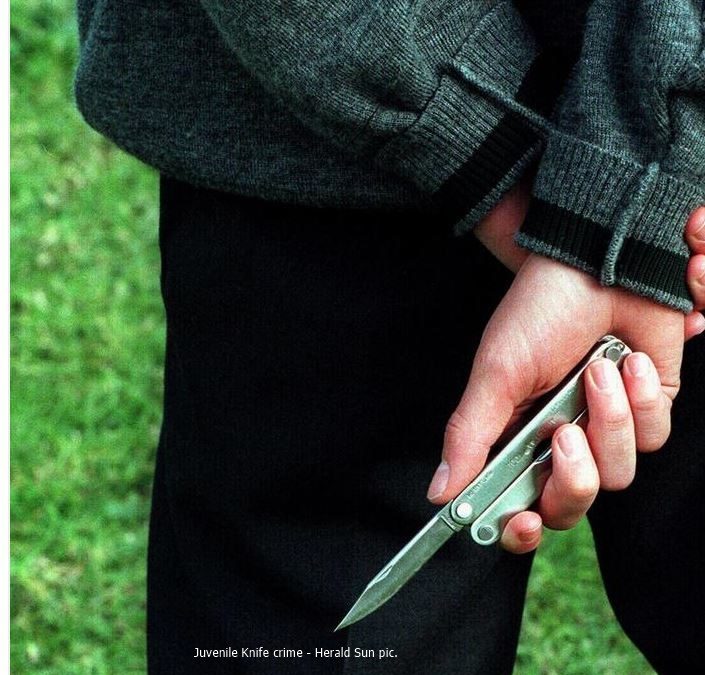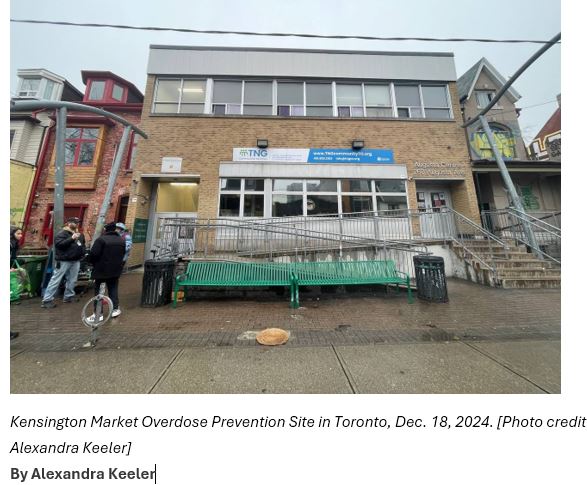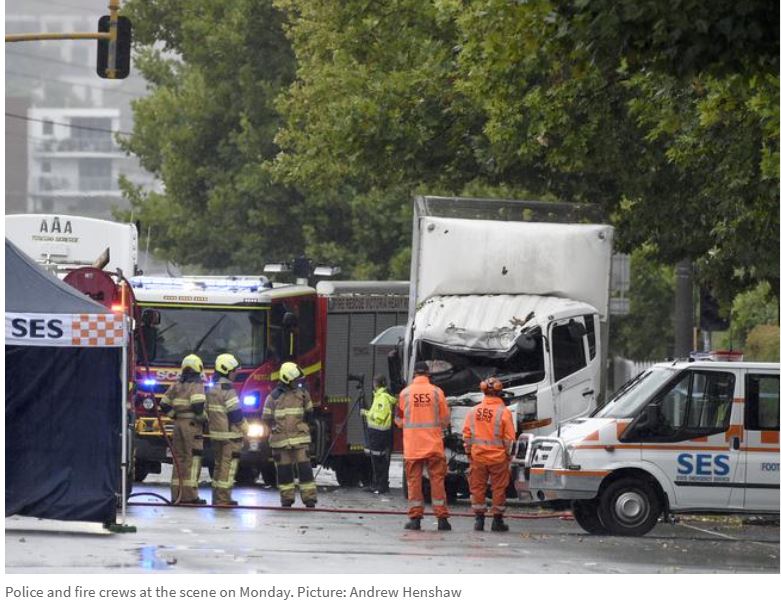
by CAA | Feb 7, 2025 | Investigations, Library, Victoria Police Issues, Youth
Police Deputy Commissioner Neil Paterson has conceded that the Police are frustrated by the leniency of the Victorian Bail Laws at a Stonington Police forum, as reported in the Herald Sun on the 7th of February 2025.
The Commissioner said that Victoria Police was advocating for change in the Court System.
It was reported that in a shocking admission by Deputy Paterson, “the force had never arrested more people for serious crimes than we have in at last 12 months.”
Nice of the Deputy to instil more fear into the community.
This admission, of course, did little to allay the community’s fears, but what is most alarming, according to the report, is that the only strategy presented to the community was the standard police line given to every such challenge of their performance.
“The policing panel announced increased foot and bicycle patrols to monitor areas including Chapel St in addition to existing initiatives to tackle crime.”
It takes a bit more than monitoring a crime hotspot, and the Zero Tolerance with the Broken Window Police strategy applied to these areas would be the most effective response.
Although a relatively short-term strategy, usually 6 months or so, the other areas of policing not reported as being discussed are proactive initiatives. The monitoring patrols, although proactive, are very limited without a broader application of proactive strategies that have a longer-term impact.
There is a major flaw in this announcement, as we have several CAA members facing similar concerns in their community and have been given the same hollow assurances. Patrols for a very limited period who do nothing more than monitor activity without enforcement, which is a ludicrous approach the community is heartily sick of.
Within a short time of these inevitably hollow assurances, the patrols diminish, while the problems persist, the police disappear completely, leaving the residents with no discernible difference in their ‘air of menace’, as one resident described the situation.
It is incredibly disappointing that the police command cannot come up with any new approaches and blaming the Courts and Bail Laws while admitting there are multiple parts to the Justice system and trying to shift all the blame on to the Justice system is disingenuous when police are clearly failing in their primary function. Preventing Crime.

by CAA | Feb 5, 2025 | Library, Media, Politics, Victoria Police Issues
Victoria can be forgiven for collectively exercising a sigh of relief at the announcement by the Allan Government about Bail Laws, Herald Sun 4th February 2025, but relief may well be premature until we see the new plans because we are not hopeful that the Government has seen the light and is proffering a solution to the worst crime rate in Victoria’s history and this may not be the silver bullet of Victoria’s hope.
The government only appears to view the problems through a narrow prism which will not lead to solutions that altering the Bail Laws is promoted to achieve.
We are not confident because the Premier has called an ‘immediate review’. Yes, that is the get-out-of-jail card so often brandished by politicians in a corner.
Pardon our scepticism, but we have seen all this before. No meaningful outcome will be achieved as the people called upon to conduct this review are the same people who advised the government on the ‘New’ crime laws passed into legislation less than six months ago that achieved little if any positive impact; at least, there is no noticeable change in the way the Courts or Police are operating that is visible.
The probability is not high that a new review by the same people and departments will expose how they got it all wrong last time.
What will happen is that the review outcome will exonerate the previous architects; the new review will see to it.
The irony is that the Premier does not even recognise the problem she is supposed to be dealing with.
There is no argument from us that the Bail Laws must be tightened, as must the judiciary’s discretion, as they will find ways to bypass possible changes to the Law.
And yes, if this is done correctly, we will see an improvement in the Law-and-Order space, but we cannot be complacent, as the crime issue will not be addressed by one magic (or not-so-magic) bullet.
All the changes in the Bail Laws may be thwarted by the judiciary, who have all seemingly overindulged in the Restorative Justice cool-aid.
The review must include how the independence of the judiciary can be retained while complying with any new strategies introduced.
Judicial accountability would be a good start.
Of equal importance is an understanding that crime prevention is the most cost-effective strategy to reduce crime. Stopping crimes happening first rather than dealing with the miscreants after they commit crimes makes absolute sense, but that does not sit well with some ideological advocates.
Seen often as the soft option, in Police parlance, Proactive policing is the only strategy shown to work.
The power of police foot patrols interacting with the community regularly is one of the most underrated weapons in the Police arsenal, but Victoria Police would instead put resources into the plethora of Task Forces and any other groups that are targeted at a particular crime after the event. We believe there are literally thousands of Police tied up in special target groups at a State and local level.
There will always be a need for some Task Force groups. Still, VicPol has become so addicted to them that they see no other alternative strategy, and there is no evidence that the Task Force approach actually works. With a rising crime rate, it is highly improbable they have any impact on the overall crime, only spasmodic impact on particular offenders who immediately get bail anyway, so the Police Task Force has been a waste of time.
Victoria has proven beyond any shadow of a doubt that recently developed strategies in combination promote /facilitate crime, not reduce it.
As we have pointed out previously, children do not enter this world with an ingrained criminal disposition; all criminal values are taught, so early intervention in a child’s development is critical, and the formative Primary School Years are the logical target area if a difference is to be achieved.
If a large percentage of police resources dedicated to Task Forces were redirected to early intervention, we would see a dramatic decline in crime.
Police performing their proper function would also see the Force attracting more recruits and retaining those they have.
The Premier would do well to ask the community what strategy they would prefer.
After all, they have to live with the consequences of whatever is implemented- this review must focus on Service Delivery as their guiding principle.

by CAA | Feb 4, 2025 | Library, Politics, Victoria Police Issues
CAA comment
This article, with comments submitted by James Basham, will be of great interest to the majority of our readers as it identifies quite clearly how the government is bereft of effective strategies to deal with terrorism and has headed down the path of a system that is loosely based on the failed Restorative Justice approach to problems in our society.
The Government really need to secure pragmatic thinkers who are not distracted by ideology to focus on how to best manage radicalisation in our society.
Critically, as this author points out, there is an absolute need for whatever system or strategy is adopted it must not bypass the current legal system, with all its flaws.
Establishing whether an individual has been radicalised based on a burden of proof of ‘the balance of probabilities’ at least gives a fair starting point to protect the wrongly accused and allow the community to defend itself.
**********************
EXTRACTS FROM THE EXECUTIVE SUMMARY OF THE AUSTRALIAN INSTITUTE OF CRIMINOLOGY (AIC) REPORT TO THE DEPARTMENT OF HOME AFFAIRS (DHA) REGARDING COUNTERING VIOLENT EXTREMISM (CVE) – AND COMMENTARY
Australian Institute of Criminology (AIC) was engaged to conduct a process and outcome evaluation of the Living Safe Together Intervention Program (LSTIP). The evaluation focused on reviewing the different models implemented in each jurisdiction, the underlying theory of change, and early indicators of positive outcomes for at-risk or radicalised individuals. The evaluation involved two principles [sic] methods—a rapid evidence assessment of effective Countering Violent Extremism (CVE) interventions and an extensive, national consultation process with stakeholders involved in the program.
THE RAPID ASSESSMENT OF ONLY POSITIVE INTERVENTIONS, TOGETHER WITH EXTENSIVE STAKEHOLDER CONSULTATIONS, ALLOWS AND PREDICTS A SERIOUSLY BIASED REPORT. IT’S UTILITY AND VALIDITY IS QUESTIONABLE… Author
When the LSTIP commenced, there was some uncertainty as to the scope of the problem and the degree to which a dedicated intervention program was required. There is an established, recognised and agreed need for the program.
THIS POINTS OUT THAT THE PROBLEM WAS ILL-DEFINED, IF AT ALL. THE LSTIP WAS A “GOOD IDEA” LOOKING FOR A PROBLEM TO SOLVE. LSTIP WAS APPLIED TO THE ILL-DEFINED PROBLEM. BUREAUCRACY IS THEN SEEKING TO JUSTIFY THE EXISTENCE AND REFINEMENT OF A SYSTEM THAT HAS AN ILL-DEFINED OR HIJACKED PURPOSE. THE LSTIP MAY DELIVER SOME COMMUNITY VALUE, BUT IT DOES NOT SQUARELY ADDRESS COMMUNITY NEEDS FOR SECURITY AGAINST RADICAL EXTREMISM – NOR SHOULD IT BE PURPORTED TO DO SO… Author
The program has become embedded within broader counter-terrorism response with the level of intervention activity commensurate to relative threat level and demand…..
FALLACY. THE PROGRAM IS NOT “…COMMENSURATE WITH THREAT…” DURING JANUARY 2025, RADICALISM IS OUTPACING AUTHORITY’S PROTECTIVE POWERS TO PREVENT COMMUNITY HARM. THE PROGRAM CAN BE EXPECTED TO CONTINUE TO FAIL TO DELIVER COMMUNITY SECURITY – EVEN IF LEGISLATED… Author
The programs are embedded as part of the broader counter-terrorism response in each jurisdiction, providing a viable alternative to arresting and monitoring at-risk individuals. All of the Intervention Coordinators can case manage clients who are referred to the program.
IF DEMONSTRATED VIOLENT RADICALISM IS THE MEASUREMENT CRITERIA, THE PROGRAM IS NOT WORKING SUCCESSFULLY – IT IS NOT VIABLE. OFFENDERS ARE FREE TO CONTINUE THEIR DAMAGING ACTIVITIES, EVEN THOUGH PERHAPS A LITTLE MORE SOCIALLY ORIENTED DUE TO THE PROGRAM. THE COMMUNITY EXPECTS AND ACCEPTS THAT OFFENDERS INVOLVED IN DRIVING UNDER THE INFLUENCE (DUI’s ) OR APPREHENDED VIOLENCE ORDERS (AVO’s) ARE ARRESTED AND/OR MONITORED. THE LAW PROVIDES FOR NUMEROUS CONTROLS TO BE APPLIED. SIMILARLY, SO SHOULD THE LAW BE APPLIED TO VIOLENT RADICALS DUE TO THEIR SERIOUSLY NEGATIVE EFFECTS ON COMMUNITIES – REGARDLESS OF AGE OR GENDER, WHICH APPEAR TO HAVE NO BEARING ON THE OFFENDING.
ALL INTERVENTION COORDINATORS ARE SAID TO HAVE THE CAPACITY TO MANAGE REFERRED CLIENTS – WHICH THAT MANAGING FOR COMPLIANCE TO THE INADEQUATE SYSTEM IS A FUTILE ACTIVITY…Author
The number of clients who have been engaged in the intervention program differs between the states and territories but appears to broadly reflect the threat level and demand in each jurisdiction.
OBVIOUSLY, THIS DOES NOT WORK TO PROTECT THE COMMUNITY BECAUSE OFFENDERS OFTEN ARE ACTUALLY REPEAT OFFENDERS – THE PROGRAM IS POWERLESS TO PROTECT THE COMMUNITY. THERE IS NO EVIDENCE OR LOGIC PRESENTED THAT SUGGESTS THAT THE PROGRAM HAS PREVENTED RADICAL BEHAVIOUR – IT’S CONSPICUOUS BY ITS ABSENCE IN THE REPORT… Author
There was broad agreement that the CVE Intervention Coordinators are committed and highly skilled individuals who have effectively established and monitored the various processes necessary for the operation of the program.
THAT’S ABOUT PROCESSES – MANAGING FOR COMPLIANCE TO THE INADEQUATE PROGRAM. IT’S NOT ABOUT OUTCOMES THAT ARE EFFECTIVE/PROTECTIVE…Author
The ability of Coordinators to form relationships with other agencies to develop referral pathways and deliver services to clients was noted as being particularly well-developed. They are proactive in identifying implementation barriers but have, at times, had limited capacity to overcome these issues.
COORDINATORS ARE PROACTIVE AND CAPABLE AT IMPLEMENTING A PARTICULARLY WELL-DEVELOPED SYSTEM – THAT SYSTEM LEAVES THE COMMUNITY VULNERABLE AND LEAVES OFFENDERS FREE TO REPEAT/RENEW THEIR OFFENDING. THE RELATIONSHIP BETWEEN THE SYSTEM/PROGRAM AND COMMUNITY SECURITY IS, AT BEST, TENUOUS..Author
…….case plans are tailored to individual needs; interventions focus on positive community integration and participation with a view to building clients’ social and emotional resilience to extremist ideologies and introducing positive influences into their social network; and access is provided to mental health services that address issues with psychopathology and antisocial traits.
WONDERFUL!!…… BUT THERE ARE NO INDEPENDENT EXTERNAL DISINCENTIVES TO DOING RADICAL COMMUNITY HARM. TOLERANCE FOR COGNITIVE DISSONANCE IS INTERNALLY CONTROLLED. SELECTIVE PERCEPTION AND CONFIRMATION BIAS HAVE PROBABLY BEEN INSTRUMENTAL IN DEVELOPING RADICALISM IN THE FIRST PLACE, AND THEY WILL CONTINUE TO APPLY TO RESIST EXPERIENTIAL LEARNING BY CLIENTS IN THE LIVING SAFE TOGETHER INTERVENTION PROGRAM (LSTIP) SYSTEM. LSTIP CLIENTS, WITH THEIR NEWFOUND SOCIAL AND EMOTIONAL RESILIENCE, MAY THEN BE EVEN BETTER EQUIPPED TO RETAIN AND CAMOUFLAGE THEIR REAL ORIGINAL VIEWS AND TO INFLUENCE OTHERS ADVERSELY… Author
However, interventions focusing on developing critical thinking and empathic skills, and those specifically focused on countering extremist ideological messaging in some way, are not being used.
THE MAJOR FOCUS OF BUREAUCRACY IS TO MAKE THE “CLIENT” FEEL LOVED [AND THEREBY ENCOURAGED TO FEEL GOOD ABOUT THEMSELVES] RATHER THAN PROVIDING THEM WITH KNOWLEDGE AND SKILLS TO FILTER INPUTS OF OTHER RADICALS AND TO UNDERSTAND THEIR IMPACT ON INDIVIDUALS AND COMMUNITY. EVEN IF THIS SERIOUS SHORTFALL WAS ADDRESSED, IT MIGHT NOT BE SUFFICIENT TO OVERCOME THE CLIENT’S TOLERANCE FOR COGNITIVE DISSONANCE [AS ABOVE]… Author
This includes improved access to mental health services, improved confidence and self-worth, forming prosocial relationships with peers, enhanced social and independent living skills, increased employability, and improved access to various government and non-government support services. There are positive signs of attitudinal change among young people with extremist views, but mixed evidence in relation to changes in behaviour and how these attitudes had manifested. ………………..there is a clear need to develop mechanisms for monitoring the progress of clients and measuring the impact of the intervention program across relevant outcome domains.
BUREAUCRACY FACILITATES/ENABLES OPPORTUNITY FOR CLIENT/OFFENDERS TO SPREAD THEIR RADICAL INFLUENCE FURTHER – AND FEEL GOOD ABOUT IT……..DESPITE HAVING “…limited data available on the impact of the intervention program”. IN THE REPORT, THIS IS HEADED AS “…promising evidence of positive outcomes….”
ACTUALLY, THE COMMUNITY IS LEFT VULNERABLE BY UNCERTAIN OUTCOMES OF A PROGRAM THAT IS NOT KNOWN TO BE EFFECTIVE.
THE EXECUTIVE SUMMARY OF THE AIC REPORT WINDS UP WITH A DAMNING STATEMENT ABOUT THE SHORTFALLS OF THE PROGRAM [LSTIP]:…Author
Among the most pressing issues are the absence of appropriate, consistent and formalised case management processes, different opinions about who should be included in the program, and concerns about the suitability of the s. 47E(d) tool, barriers to information sharing, the lack of consistent agreement about the aim of the program and definition of success, unanswered questions regarding the need for an intervention component, and concerns about the longer-term sustainability of the LSTIP.
THE LSTIP PROGRAM MAY DELIVER SOME DESIRABLE SOCIAL OUTCOMES, BUT IT IS NOT THE ANSWER TO VIOLENT EXTREMISM IN OUR COMMUNITY.
IT WOULD BE IRRESPONSIBLE TO LEGISLATE INTERVENTION ATTENDANCE BY EXTREMISTS IN THE MISTAKEN BELIEF THAT IT IS A SOLUTION TO THE SECURITY PROBLEMS THEY PRESENT.

by CAA | Jan 28, 2025 | Library, Victoria Police Issues, Youth
If we are accused of banging on about the role of Police and schools, we plead guilty as charged.
The reason is two irrefutable facts.
Firstly, all, and we mean every one of the juvenile miscreants who are terrorising our community, go through the education/schools system.
Non-attendance is the first indicator of those children who need special attention.
So it is without apology that we push for that being the place to start, ground zero of criminality, and the Police must play a critical role in this.
After much criticism of VicPol by us and others of the lack of a Police in Schools Program (PSIP), a quasi-Police Schools program was introduced. This role was added to the commitments of police, who were already overloaded. And it is the next best thing to useless in this fight. It is unfair to the members and has extremely low effectiveness in the crime fight.
The reason this pretend program won’t work is that by its nature, it is spasmodic, and children only respond to regular commitments and will only develop meaningful relationships with the Police member as a person if the relationship is stable. It is precisely the same as teaching children about mathematics learning by rote and consistency. It is also the same dynamic that builds effective families- consistency.
It should also be accepted that a contributing factor in the attrition rate of Police is the lack of proactive work being undertaken. The Police members see the impact of juvenile crime and the lack of diversion available to them to steer young people away from crime, leading to their frustration with the policing role’s effectiveness.
There can be no better example of frustration leading to the loss of a very competent Police officer than the Opposition leader, Brad Battin, who was heavily involved in Operation New Start, a police volunteer organisation partnered by teachers and Service Club Members who worked together to ensure young people got to and stayed at school.
VicPol allegedly cancelled the program on the basis that it was too labour-intensive. That the program worked very well was not a consideration. The program was scuttled. Brad had had enough and resigned from the Force.
Now mature adults who went through the original Police In Schools Program can still and often do quote the name of the Police member who helped guide them many years ago, which is an accurate measure of the effectiveness of that program.
Being at the school on the same day at the same time to deliver a structured curriculum is the key, and anything less is of seriously questionable effectiveness and rates in the category of spin, something to distract critics.
The Government, Police or even, to a lesser extent, the schools tend to overlook the inescapable reality that amid those students walking through the door for their first day of school are the future juvenile offenders who will end up wreaking havoc in our community.
The community is getting sick and tired of bureaucratic buck-passing and inaction as those responsible seemingly take no action to stem the tide.
We cannot point to one initiative the government has introduced that stems this problem.
On the contrary, the government has introduced initiatives that feed into the juvenile cohort and are irresponsible.
The raising of the age of criminal responsibility allows those children who start their life of crime at a young age to escape any sanction to modify their behaviour until they are sometimes three to four years older. By then, they are well entrenched in the criminal sphere – too late to berate or lecture because it won’t work.
Softening Bail and custodial sentences to the point of abolishing them also feeds into the rise of juvenile crime, as there are no consequences for their behaviour. Moreover, criminal enterprises, whether local or large ones, can entice young people to commit crimes on the basis that nothing will happen if they are caught.
The second irrefutable fact is the solutions are in front of them.
Having programs to ensure school attendance and building relationships between the children and the Police as the symbol of authority in the classroom and socially at Blue Light Disco’s will work.
The highly successful Police In Schools program, Operation New Start, a program that got kids to school, and Blue Light are three initiatives that need to be urgently reintroduced to arrest the rot, devastating the future of too many of our children.
It is sad that Blue Light, which started in Victoria, is thriving in every other state and territory, with many Blue Lights operating in other countries but very few operating in Victoria.
These programs fed off each other and were highly successful when they were introduced.
The Force continues to promote the notion that they are understaffed, and to a degree, this may be true. However, staffing is all about priorities and stopping crime before it happens must be rated as the primary use of resources.
Any run-of-the-mill manager can achieve more productivity with more or unlimited staff; whether they are effective is moot; it takes a leader to prioritise the way out of the imbroglio of juvenile crime.
Crowing about arrests, as is often the case, as the police executive bustle to promote their performance; sadly, catching crooks is a higher priority than stopping crime in the first place. Task Forces are prolific, but not one is dedicated to stopping crime before it happens. They are all reactive, responding to demands that have occurred.
The frontline Police know what must be done; only the Executive seem to have their heads in the sand, hoping the problem will go away instead of making the hard decisions to change the course of criminality and Force priorities.
VicPol may even slow the exodus of police from their careers if members realise that they can become involved in meaningful programs that make a difference. Simply taking the miscreants to court to be continually bailed and then at court hearing all the excuses as to why the perpetrator should not be locked up to protect the offender from themselves and the broader community is extremely frustrating for police who know that there are better ways.
Often, understated is the financial impact on all victims as they open their annual insurance bills to see substantial increases and no matter how those increases are subject to spin, the reality is that insurance companies do not lose money as they adjust their premiums to the claims. With out-of-control crime, those premiums are skyrocketing.
Crime prevention is just as, or even more critical than, arresting criminals; just ask the victims.

by CAA | Jan 26, 2025 | Library, Politics, Victoria Police Issues

CAA SUBMISSION ON PROPOSED AMENDMENTS
to the
TERRORISM (COMMUNITY PROTECTION) AND CONTROL OF WEAPONS AMENDMENT BILL 2024
The principles of this legislation are flawed.
PART 1 TERRORISM COMMUNITY PROTECTION
There is nothing in this amendment that would in any way improve or provide any Community Protection.
The concept of this Bill as a community protection initiative is absurd as it identifies at-risk individuals and invites them to volunteer for the MAP program.
And there are serious questions about the efficacy of deradicalisation programs.
As reported in the Herald Sun on 15th of Jan ’25, under the banner ‘Deradicalisation programs have mixed impact, report says’,
“Deradicalisation programs have failed to change the behaviour of high-risk individuals authorities fear could commit acts of terror in Australia or produce data on whether the initiative actually works.
Further, there have been a small number of cases where the risk associated with clients had escalated and required the involvement of law enforcement.”
The revelations come amid rising reports of antisemitism and after a spate of attacks by individuals in deradicalisation programs last year”.
This report highlights the folly of relying on bureaucratic processes to manage such an important function to protect the community instead of the legal system.
If legislation is deficient, correct it and empower the law enforcement process to manage these extremists. Courts can at least make binding orders to mitigate risk, something the bureaucracy can’t do.
We were stunned to discover two operational deradicalisation programs, LSTIP and MAPS.
Establishing a deradicalisation industry is obviously on its way, which leads to suspicion that the growth of this industry has more to do with the players involved in creating their quango rather than protecting the community, which appears to be a by-product at best.
Again, this initiative is designed to help the perpetrators, not the public. The perpetrator-first approach is the hallmark of Restorative Justice, a flawed approach to crime and/or antisocial behaviour where the perpetrator is rewarded rather than punished.
The reliance on deradicalisation is a significant flaw as there is no empirical data to suggest the likelihood of success and no reliable mechanism to guarantee that deradicalisation has been achieved; the expert consensus is that it has a hit-and-miss success rate.
To rely on such a system to protect the community is an abdication of the government’s responsibility and should something go awry. The government should be held accountable alongside the perpetrator.
How is this protection manifested? How do the Community feel protected,
The community do not know who these individuals are, where they are located and the circumstances of their radicalisation.
A family may choose to change their circumstances if they become aware of somebody close being identified as being either potentially or actually radicalised. Moreover, the employment arrangements involving the perpetrator may vary legitimately when an employer finds out an employee is on that path.
Why should the community be left in the dark? That is not community safety. It is protection for the perpetrator.
The amendments do not address these issues, leaving the government with substantial liability if things go wrong, and they fail to let people know the risks.
We live in a democracy, and nobody should be exposed to sanctions by the government bureaucracy. This is an unambiguous role of the courts. The High Court has had plenty to say about this question recently.
The volunteer nature of persons entering the MAP program leaves open the allegations of coercion to volunteer, such as” Have we got a deal for you”?
As for the perpetrator, there appears to be no effort to include protection for their rights once they are nominated as potentially or actually being radicalised. At what stage can their rights be interfered with is, or should it be a matter for a Court, not the bureaucracy?
The failure to process suspects in the normal consequence through the Courts is a failure of democracy – they are voluntarily coerced into accepting they are radicalised, and they are entirely processed administratively, losing all rights.
The high court has been clear on the application of penalties by bureaucrats and not the Courts, and no matter how much bureaucrats may pretend otherwise, MAPS and LSTIP are sanctioning.
We are not arguing against the concept of deradicalisation, but we are saying that the courts, not bureaucrats, must manage it. At least that way, the radicalisation has to be proven beyond a reasonable doubt or on the balance of probabilities, not some obscure administrative process.
If the current offences do not adequately cover these situations, new legislation must be enacted to ensure the Courts manage these people.
A parallel to understanding the folly of this approach would be to have the community advise a bureaucracy of a regular drunk driver. That driver is offered an alcoholic program but continues to drive under the influence.
A second and more current initiative is Pill Testing, where the government will test your illicit pills and give you the green light to take them. They are still illicit, and the tests only cover the pill presented, not the ones being consumed.
Their efforts, and there are more, indicate a trend where any personal accountability and responsibility is diminished and fuelled by government intervention.
The long-term result will be the diminished need or perhaps elimination of some courts as their function is demoted so that governments can control these matters through their bureaucracies. We will all then live in a Restorative Justice nirvana.
The cost of a democracy designed to manage the individuals without checks and balances the Courts would provide is horrendous, and the energy expended would be far better used to fit the suspected radicalised individual with an ankle bracelet based on a court order.
That would protect the individual from malice by false accusations and protect the community, whereas the voluntary program will not.
Part 2 CONTROL OF WEAPONS AMENDMENT BILL 2024
The Control of Weapons Bill amendments should repeal the whole Act and ensure that police have the power to do their job. This is a switch-on-switch-switch-off approach that is clearly aimed at controlling police operations without the expectation of any positive outcome, either proactively or reactively.
It is also a dangerous and direct attack on the essential independent operational function of policing.
It is ludicrous for Police to declare an area subject to exercising powers unless an improbable agreement can be made that all perpetrators restrict themselves to the given controlled area.
Controlled weapons do not gain status by being carried in a declared area, so the concept of controlled areas is absurd. They are always a controlled weapon no matter where they are carried.
The perpetrators only need to avoid the area to avoid detection – that doesn’t stop the problem; it simply relocates it. If anybody is found by Police with a weapon in the declared area, they obviously didn’t read the paper. The foolhardiness of this approach is the people who carry controlled weapons are most unlikely to read the paper or go online to the police site to check where the police operations are.
This strategy follows the line of the approach to the drug problem – providing injecting facilities – providing drug paraphernalia to addicts, and testing pills, all deliver the same message that these things are not really illegal because the government is facilitating them.
That’s how the warnings of declared areas will be interpreted.
The weapons are the same; therefore, perpetrators must be subject to the same risks of getting caught irrespective of where they are and when.
If the legislation is deficient in this area, the amendments must enhance the ability of the Police to intervene in the carriage of any controlled weapon.
Anybody carrying a controlled weapon in any place at any time must be able to be arrested and prosecuted. Police must have the power to search and seize based on reasonable suspicion. Reasonable can be tested by the courts.

by CAA | Jan 23, 2025 | Library, Victoria Police Issues, Youth
A headline in the Herald Sun on the 21st of January 2024 stated that reported crime at schools is at a 10-year high, with classroom crimes hitting 120 times a week.
While a percentage of offences have been after hours, with schools needing to suspend 90 students daily, a real problem of discipline is exposed.
Further, if anybody does not see the correlation between crime in our schools and the upsurge in juvenile crime, more generally, they have their head in the sand.
These problems can’t be reasonably palmed off as crimes by others outside school hours; there is an inescapable nexus between the school environment and after-hours crime, for the most part.
Nothing in the statistics would indicate that the students are not responsible for much of the after-hours of crime.
Schools should be a place of learning, and learning to be a criminal is not one of the skills we would embrace.
It was reported that schools can exercise discretion as to whether to report an incident to the police, and this is part of the problem leading to inconsistencies in crime responses.
Police are the only ones with the legislative power of discretion, and when a crime comes to the notice of a school, it must be reported to the police; if not a legal obligation, the school has a moral one to the whole school and general community, to which it is responsible. Protecting a student from an investigation is not the school’s role, as the investigation is how the truth will be determined; schools are not equipped to perform this function.
That this problem has reached this stage indicates that Victoria Police have had their priorities wrong and have had them wrong for nearly 15 years.
Interestingly, the CAA was established 10 years ago this year to address the issue of the Police’s failure to manage youth crime adequately.
Central to the management of youth crime is the reintroduction of the Police in Schools Program (PSIP)
The current schools program Victoria Police currently operates, is a shadow of the real program and probably no more effective than no program. You can’t expect positive results from a spasmodic ‘half-hearted’ approach. The ‘when we have time to do it’ approach will not work.
The CAA tried to establish a Police Veterans in Schools Program, and despite the best adverse efforts by the then Chief Commissioner Ashton to stymie the program, it was thwarted in the end by COVID-19. The first Police Veteran to enter a school under this program coincided with the introduction of COVID restrictions.
We recruited the first 12 schools we approached, and recruited a number of Police veterans to service them following the PSIP curriculum model.
Unfortunately, we are not well enough resourced to try it again. Still, there is no reason that VicPol could not recruit retired members to fulfil the Police in Schools Officer role, reducing the impact on other operational needs.
The argument proffered is that VicPol’s resources cannot support such a program. Still, Policing is about priorities, and when the Force has a reactive corporate mindset, proactive work to prevent crime pays the priority price.
Ironically, the Chief Commissioners in recent history who have achieved outstanding results each had the balance between proactive and reactive about right, and crime was managed. We also had a much safer State and a Police Force that was highly respected and engaged.
These shocking statistics are the responsibility of the current Chief Commissioner and the Police Executive, nobody else, and it is within their remit to resolve the matters.
The place to start is the schools. Don’t blame the parents, the legislators, or the courts, although they play a part in it. The blame is sheeted directly to the Force management. Excuses are a sign of inept managers. It is no doubt they will argue they haven’t got the resources, but they haven’t got the resources not to do it either.
We understand there is currently an internal management review in place, which would provide the opportunity for a good look at the Force’s priorities and effective management of resources.
This review must go beyond just ‘shuffling the deck chairs’ to make it look like the Force is doing something, but experience tells us unless the review addresses all the causes, nothing much will change.
One area that needs serious re-evaluation and de-prioritising is the task force groups; historically, they have been the easy go-to tool of police management, but the impact on the ability of the Force to provide adequate policing overall is adversely impacted and rarely a consideration, generally leading to more crime than the Task Forces are set to address.
There will always be a need for some Task Forces, but their establishment must be carefully managed as once established, it is very hard to invoke a sunset clause to their operation as the participants quickly gain a comfort factor in the privilege of working on a Task Force, being able to ditch their uniform in favour of a US Special Forces style dress up, generally avoiding shift work and gaining their rest days predominately on weekends, a cherished part of work-life balance not shared by Police working on stations, the real front line.
These task forces aggravate the operations of VicPol because the best and brightest, hardest workers are usually selected for these roles seen as prestigious, leaving stations void of experienced police.
It is too easy a solution to any crime outbreak to establish a task force or a targeted group by any other name. These groups are often given other titles to avoid the perception of the incorrect weighting of this type of policing.
As an example of the types of inefficiencies, a drug dealer moved into our local area and openly traded his wares predominantly on a Thursday. Lines of cars would enter the street with a line of people all carrying similar $2 candy-stripped carrier bags, obviously containing ill-gotten gains to trade for drugs.
The community reported the matter with an offer of an observation post in the house directly opposite, which was readily accepted by the Police.
This criminal activity was blatant to the degree that the transactions could be seen clearly from the observation point.
The community expected the matter to be resolved within a couple of weeks, maybe, but the activity continued for over three months, with the Police observing and the crook expanding his business to a nearby rented factory, so prolific was the activity.
A properly planned and orchestrated police operation could have netted numerous thieves and drug users on many occasions, including the primary offender, and the result would have been no less effective than dragging it out for over three months; after all, the penalty is the prerogative of the courts and all this extra work, we would argue, would not add to the severity of the sentence once the primary perpetrator was eventually arrested. However, the delay would adversely contribute to the crime statistics.
One thing is for sure: the responsible citizen who tolerated the disruption to their family by Police sitting in their front room for months on end, 24/7 will not offer that privilege to the Police again. Particularly, when technology could have achieved better quality evidence.
Alienating the citizens who hitherto supported police is not good policing by any measure.
A pragmatic measurement of this operation would demonstrate that when all matters are taken into consideration, it was inefficient and poorly managed.
The question, therefore, arises of how many other similar operations are inefficient and should have their resources redirected to proactive prevention measures and the operational front line.

by CAA | Jan 21, 2025 | Library, Victoria Police Issues, Youth
A new Magistrate appointment dedicated to dealing with repeat juvenile offenders has been announced, Herald Sun 20th of January 2025.
Does this mean the Government has lost confidence in the magistracy of this State to deal with repeat offenders, or is it nothing more than a ploy to give the appearance of doing something? Given that they haven’t addressed a primary cause, the failure of legislation, this is probably only a political spin.
As they say, the proof will be in the pudding, but we are not confident that anything will change.
When reviewing this Government approach to juvenile crime, to suggest it is ‘lacklustre’ is an understatement.
More than half the Children’s Courts across the State have been closed, and weak bail laws allow juveniles to ‘give the thumb’ to authority.
A whole cohort of juvenile offenders has been excluded from the Justice system by raising the age of criminal accountability; therefore, the younger cohort offends with impunity and avoids accountability, so no intervention can occur to steer them away from joining the ranks of the repeat offenders.
The youth crime surging to a 14-year high is only the beginning, not the end; we have more pain to come. And that is the pain suffered by the victims whilst the judiciary is immune.
If the government has not lost faith in the Magistrates of this State as this appointment indicates, the public certainly has. Young thugs, by their actions, treat the Courts, at best, as an inconvenience or, more likely, a joke.
Continually, we read how young thugs are bailed for various very serious crimes that are committed while they are on bail for equally serious charges.
It is not uncommon for thugs who have been bailed on multiple occasions, sometimes 30-50 times, to be granted bail again. And that is ridiculous and unconscionable. This is aggravated by the rising age of criminality, where there is no intervention to redirect the younger juveniles but instead teaches them there are no consequences for their criminal actions.
The Government is blind or ignoring the causes; where do they think the quantitative surge in juveniles is fed from? It is the 8-12 year olds providing the impetus.
Figures previously released to the Herald Sun revealed more than 100 kids aged between 10 and 17 years old were involved in at least 30 crimes each in 2024.
That number has tripled over the last five years.
There were just 34 youths offending at a minimum of 30 crimes a year in 2019.
The 103 repeat offenders recorded last year carried out at least 3090 crimes in 2024 alone, an average of eight offences per day.- Herald Sun.
The actual number of offences committed is doubtless very much higher.
The major problem is either the structure of legislation currently in vogue or the judiciary have steered away from convention and have embarked on ideological fantasy escapade, or both, which is our pick.
It was not so long ago; Police were reporting that 30 or so prime thugs were committing the majority of the crimes. That has now not only been debunked, but the number has tripled to 103.
How the appointment of one Magistrate will rectify the anomalies of a broken judicial process is beyond comprehension.
An outstanding omission in the Government’s response was the limited reference to Victims by the Youth Justice Minister quoted as saying,
“We know there is a group of repeat offenders driving the rise in serious crimes – that’s why we’re taking action to hold them to account while offering support to help young people turn their lives around.”
Youth Justice Minister Enver Erdogan said: “This is another important step in delivering a justice system that protects the community and rehabilitates young people”.
“We want to help victims get closure by holding young people to account and helping those heading down a wrong path realise the effects of their actions.”
Minister, if you want to help victims, helping them get closure genuinely is arrant nonsense. How about first stopping the crime and the impact on victims? How about re-introducing some of the past programs, not just paying lip service to the past programs but genuinely embracing them? Why do you want to turn lives around rather than stop them from offending in the first place, which would be the sensible approach?
The key is directing young people away from crime before, not after the fact. It is called prevention.
We are seeing disturbing reports of student misbehaviour in schools, and yet the proven Police in Schools Program, Operation New Start and Blue Light, has not been embraced to deal with this; instead, a facsimile to look like the original police school program is touted but it has not been demonstrated it works. A mere shadow of the real program.
We are unsure, but the age change to criminal liability may have completely scuttled the Police Cautioning program, the real bulwark against younger children moving through the criminal spheres to become the next generation of repeat offenders. Although it can’t be quantified accurately, the Police Cautioning Program was responsible for diverting vast numbers of young people from a life of crime.
We wish the new Magistrate well but are not hopeful that she will make a scrap of difference. At the same time, the Government fails to acknowledge and address their failures in relation to Bail, other legislative blunders and Police operational failures that feed this growing problem.
With this new Magistrate’s depth of experience, she should first be tasked with reviewing the legislation to make it effective, and then she may have something to work with. Still, as the status quo continues, she has little hope of pushing back against the Restorative Justice ideology that has infected our judiciary, one of the main causes of the judicial failures.
The Courts must follow the Law, not an ideology.

by CAA | Jan 17, 2025 | Illicit Drugs, Library, Victoria Police Issues
CAA comment
Opponents to the concept of involuntary care trot out the ‘hoary old chestnut’ of a patient’s rights, but when it comes to rights, we argue every person has a right to care appropriate to their health issue. If that means involuntary care, then we support that approach.
When a person’s acuity is so manipulated by deleterious health, then in the name of humanity, we must take care of them until they are well enough to look after themselves.
Our view is tempered in that there needs to be clear medical oversight as there must be legal oversight to ensure the patient’s rights are protected and the community, one does not outrank the other.
A mechanism to have any person taken into temporary care to be assessed and the necessary information placed before a Court to determine whether the person’s involuntary care should continue and for the accountability intervals to the Court for their continued involuntary care is the mechanism that we should aspire to develop.
Police and Ambulance first responders must be given the power to place people whose acuity is compromised into temporary care to be medically assessed.
Temporary Health Orders would be the most logical authority mechanism. They were thrown around with ‘gay abandon’ during the COVID-19 pandemic, so it should be well accepted by the community.
The imminent closure of one a Victorian jail provides an opportunity for the facility to be converted to accommodate involuntary patients, and in tight fiscal times the cost to the government in paying out on contracted services to operate the prison for many years may provide some financial benefit to the State – at least we will be getting something back including saving some lives currently wasted.

Some politicians, police and community groups argue involuntary care is key to addressing severe addiction and mental health issues
The brutal stabbing last month of a 58-year-old city employee in Nanaimo, B.C., made national headlines. The man was stabbed multiple times with a syringe after he asked two men who were using drugs in a public park washroom to leave.
The worker sustained multiple injuries to his face and abdomen and was hospitalised. As of Jan. 7, the RCMP were still investigating the suspects.
The incident comes on the heels of other violent attacks in the province that have been linked to mental health and substance use disorders.
On Dec. 4, Vancouver police fatally shot a man armed with a knife inside a 7-Eleven after he attacked two staff members while attempting to steal cigarettes. Earlier that day, the man had allegedly stolen alcohol from a nearby restaurant.
Three months earlier, on Sept. 4, a 34-year-old man with a history of assault and mental health problems randomly attacked two men in downtown Vancouver, leaving one dead and another with a severed hand.
These incidents have sparked growing calls from politicians, police and residents for governments to expand involuntary care and strengthen healthcare interventions and law enforcement strategies.
“What is Premier Eby, the provincial and federal government going to do?” the volunteer community group Nanaimo Area Public Safety Association said in a Dec. 11 public statement.
“British Columbians are well past being fed-up with lip service.”
‘Extremely complex needs’
On Jan. 5, B.C.’s newly re-elected premier, David Eby, announced the province will open two involuntary care sites this spring. One will be located at the Surrey Pretrial Centre in Surrey and the other at the Alouette Correctional Facility in Maple Ridge, a city northeast of Vancouver.
Eby said his aim is to address the cases of severe addiction, brain injury and mental illness that have contributed to violent incidents and public safety concerns.
Involuntary care allows authorities to mandate treatment for individuals with severe mental health or substance use disorders without their consent.
Amy Rosa, a BC Ministry of Health public affairs officer, confirmed to Canadian Affairs that the NDP government remains committed to expanding both voluntary and involuntary care as a solution to the rise in violent attacks.
“We’re grappling with a growing group of people with extremely complex needs — people with severe mental health and addictions issues, coupled with brain injuries from repeated overdoses,” Rosa said.
As part of its commitment to expanding involuntary care, the province plans to establish more secure facilities and mental health units within correctional centres and create 400 new mental health beds.
In response to follow-up questions, Rosa told Canadian Affairs that the province plans to introduce legal changes in the next legislative session “to provide clarity and ensure that people can receive care when they are unable to seek it themselves.” She noted these changes will be made in consultation with First Nations to ensure culturally safe treatment programs.
“The care provided at these facilities will be dignified, safe and respectful,” she said.
‘Health-led approach’
Nanaimo Mayor Leonard Krog says involuntary care is necessary to prevent violent incidents such as the syringe stabbing in the city’s park.
“Without secure involuntary care, supportive housing, and a full continuum of care from detox to housing, treatment and follow-up, little will change,” he said.
Elenore Sturko, BC Conservative MLA for Surrey-Cloverdale, agrees that early intervention for mental health and substance use disorders is important. She supports laws that facilitate interventions outside of the criminal justice system.
“Psychosis and brain damage are things that need to be diagnosed by medical professionals,” said Sturko, who served as an officer in the RCMP for 13 years.
Sturko says that although these diagnoses need to be made by medical professionals, first responders are trained to recognise signs.
“Police can be trained, and first responders are trained, to recognise the signs of those conditions. But whether or not these are regular parts of the assessment that are given to people who are arrested, I actually do not know that,” she said.
Staff Sergeant Kris Clark, a RCMP media relations officer, told Canadian Affairs in an emailed statement that officers receive crisis intervention and de-escalation training but are not mental health professionals.
“All police officers in BC are mandated to undergo crisis intervention and de-escalation training and must recertify every three years,” he said. Additional online courses help officers recognise signs of “mental, emotional or psychological crisis, as well as other altered states of consciousness,” he said.
“It’s important to understand, however, that police officers are not medical/mental health professionals.”
Clark also referred Canadian Affairs to the BC Association of Chiefs of Police’s Nov. 28 statement. The statement says the association has changed its stance on decriminalization, which refers to policies that remove criminal penalties for illicit drug use.
“Based on evidence and ongoing evaluation, we no longer view decriminalization as a primary mechanism for addressing the systemic challenges associated with substance use,” says the statement. The association represents senior police leaders across the province.
‘Life or limb’
Police services are not the only agencies grappling with mental health and substance use disorders.
The City of Vancouver told Canadian Affairs it has expanded programs like the Indigenous Crisis Response Team, which offers non-police crisis services for Indigenous adults, and Car 87/88, which pairs a police officer with a psychiatric nurse to respond to mental health crises.
Vancouver Coastal Health, the city’s health authority, adjusted its hiring plan in 2023 to recruit 55 mental health workers, up from 35. And the city has funded 175 new officers in the Vancouver Police Department, a seven per cent increase in the force’s size.
The city has also indicated it supports involuntary care.
In September, Vancouver Mayor Ken Sim was one of 11 B.C. mayors who issued a statement calling on the federal government to provide legal and financial support for provinces to implement involuntary care.
On Oct. 10, Conservative Party Leader Pierre Poilievre said a Conservative government would support mandatory involuntary treatment for minors and prisoners deemed incapable of making decisions.
The following day, Federal Minister of Mental Health and Addictions Ya’ara Saks said in a news conference that provinces must first ensure they have adequate addiction and mental health services in place before discussions about involuntary care can proceed.
“Before we contemplate voluntary or involuntary treatment, I would like to see provinces and territories ensuring that they actually have treatment access scaled to need,” she said.
Some health-care providers have also expressed reservations about involuntary care.
In September, the Canadian Mental Health Association, a national organization that advocates for mental health awareness, issued a news release expressing concerns about involuntary care.
The association highlighted gaps in the current involuntary care system, including challenges in accessing voluntary care, reports of inadequate treatment for those undergoing involuntary care and an increased risk of death from drug poisoning upon release.
“Involuntary care must be a last resort, not a sweeping solution,” its release says.
“We must focus on prevention and early intervention, addressing the root causes of mental health and addiction crises before they escalate into violent incidents.”
Sturko agrees with focusing on early intervention but emphasises the need for such interventions to be timely.
“We should not have to wait for someone to commit a criminal act in order for them to have court-imposed interventions … We need to be able to act before somebody loses their life or limb.”

by CAA | Jan 12, 2025 | Illicit Drugs, Library, Politics, Safe Injecting Rooms, Victoria Police Issues
CAA Comment
This is another insightful article in this important series, dealing with the inevitable pushback from the pro-drug injecting room lobby.
What is not addressed is the weight that should be given to this group and do they have a vested interest.
The argument is over establishing Homelessness and Addiction Recovery Treatment (HART) Hubs in lieu of safe injecting rooms.
A very similar concept to the position of the CAA.
As a society, we would not tolerate accepting that a person with any sort of health issue was not treated, but rather, their affliction or disease was just managed, and the causes were actively facilitated when cures were available.
We will be closely watching the legal ramifications of the options to close and modify Injecting Rooms and convert them to Hart Hubs. Altogether a sound strategy from which addicts may recover from their illness rather than the addiction being fed.

The operator of a Toronto overdose prevention site is challenging Ontario’s decision to prohibit 10 supervised consumption sites from offering their services.
In December, Neighbourhood Group Community Services and two individuals launched a constitutional challenge to Ontario legislation that imposes 200-metre buffer zones between supervised consumption sites and schools and daycares. The Neighbourhood Group will be forced to close its site in Toronto’s Kensington Market as a result.
In its court challenge, the organization is arguing site closures discriminate against individuals with “substance use disabilities” and increase drug users’ risk of death and disease.
The challenge is the latest sign of growing opposition to Ontario’s decision to either shutter supervised consumption sites or transition them into Homelessness and Addiction Recovery Treatment (HART) Hubs. The hubs will offer drug users a range of primary care and housing solutions, but not supervised consumption, needle exchanges or the “safe supply” of prescription drugs.
Critics say the decision to suspend supervised consumption services will harm drug users and the health-care system.
“We’re very happy that the HART Hubs are being funded,” said Bill Sinclair, CEO of Neighbourhood Group Community Services. “They’re a great asset to the community.”
“[But] we want HART Hubs and we want supervised consumption sites.”
‘Come under fire’
On Thursday, the Ontario government announced that nine of the 10 supervised consumption sites located near centres with children would transition into HART Hubs. The Neighbourhood Group’s site is the only one not offered the opportunity to transition, because it is not provincially funded.
Laila Bellony, a harm reduction manager at a supervised consumption site at the Parkdale Queen West Community Health Centre in Toronto, says she is worried that drug users may avoid using HART Hubs altogether if they do not facilitate the use of drugs under the supervision of trained staff.
Data show this oversight can prevent deaths by facilitating immediate intervention in the event of an overdose.
Bellony is also concerned the site closures will increase the strain on other health-care services. She predicts longer wait times and bed shortages in hospital emergency rooms, as well as increased paramedic response times.
“I think the next thing that will happen is the medical or health-care system is going to come under fire for being sub-par. But it’s really all starting here from this decision,” she said.
She questions how the HART Hubs will meet demand for detox and recovery services or housing solutions.
Parkdale Queen West Community Health Centre and its sister site, the Queen West Site, serve hundreds of clients, Bellony says. By contrast, Ontario’s HART Hub rollout plan indicates all 19 hubs will together provide 375 new housing units across the province.
“The HART Hub model is not a horrible model,” said Bellony. “It’s the way that it’s being implemented that’s ill-informed.”
In a response to requests for comment, a media spokesperson for the Ontario Ministry of Health directed Canadian Affairs to its August news release. That release lists proposals for increased safety measures at remaining sites, and a link to a HART Hub “client journey.”
On Dec. 3, the Auditor General of Ontario, Shelley Spence, released a report criticizing the health ministry’s “outdated” opioid strategy, noting it has not been updated since 2016.
National data show a 6.7 per cent drop in opioid deaths in early 2024. But experts caution it is too soon to call it a lasting trend. Opioid toxicity deaths in 2023 were up 205 per cent from 2016.
“We concluded that the Ministry does not have effective processes in place to meet the challenging and changing nature of the opioid crisis in Ontario,” the auditor general’s report says.
“The Ministry did not … provide a thorough, evidence-based business case analysis for the 2024 new model … [HART Hubs] to ensure that they are responsive to the needs of Ontarians.”
 ‘Ill-informed’
‘Ill-informed’
Ontario has cited crime and public safety concerns as reasons for blocking supervised consumption sites near centres with children from offering their services.
“In Toronto, reports of assault in 2023 are 113 per cent higher and robbery is 97 per cent higher in neighbourhoods near these sites compared to the rest of the city,” Ontario Health Minister Sylvia Jones’ office said in an Aug. 20 press release.
The province has also cited concerns about prescription drugs dispensed through safer supply programs being diverted to the black market.
Police chiefs and sergeants in the Ontario cities of London and Ottawa have confirmed safer supply diversion is occurring in their municipalities.
“We are seeing significant increases in the availability of the diverted Dilaudid eight-milligram tablets, which are often prescribed as part of the safe supply initiatives,” London Police Chief Thai Truong said at a Nov. 26 parliamentary committee meeting examining the effect of the opioid epidemic and strategies to address it.
But Bellony disputes the claim that neighbourhoods with supervised consumption sites experience higher crime rates.
“Some of the things that [the ministry is] saying in terms of crime being up in neighbourhoods with safe consumption sites — that’s not necessarily true,” she said.
In response to requests for information about the city’s crime rates, Nadine Ramadan, a senior communications advisor for the Toronto Police Service, directed Canadian Affairs to the service’s crime rate portal.
The portal shows assaults, break-and-enters and robberies in the West Queen West neighbourhood have remained relatively stable since the Queen West supervised consumption site opened in 2018.
In contrast, crime rates are higher in some nearby neighbourhoods without supervised consumption sites, such as The Junction.
“While I can’t speak to perceptions about a rise in crime specifically around supervised consumption sites, I can tell you that violent crime is increasing across the GTA,” Ramadan told Canadian Affairs. She referred questions about Jones’ statements about crime data to the health minister’s office.
Jones’ office did not respond to multiple follow-up inquiries.
Mixed feelings
In July, Canadian Affairs reported that business owners in the West Queen West neighbourhood were grappling with a surge in drug-related crime.
Rob Sysak, executive director of the West Queen West Business Improvement Association, says there are mixed feelings about their neighbourhood’s site ceasing to offer safe consumption services.
“I’m not saying [the closure] is a positive or negative decision because we won’t know until after a while,” said Sysak, whose association works to promote business in the area.
Sysak says he has heard concerns from business owners that needles previously used by individuals at the site may now end up on the street.
Bellony supports the concept of HART Hubs, offering addiction and support services. But she says she finds the province’s plan for the hubs to be unclear and unrealistic.
“It seems very much like they kind of skipped forward to the ideal situation at the end,” she said. “But all the steps that it takes to get there … are unaddressed.”

by CAA | Jan 8, 2025 | Investigations, Library, Media, Politics, Road Safety, Victoria Police Issues
A 67-year-old male driver lost his life when his small car was destroyed by a speeding truck.
The truck was allegedly stolen, and Police had failed to stop it using ‘stop sticks’.
Apart from the ‘stop sticks’ being old problematic technology, we need to look further as to why this life was wasted and what systematic failures contributed to the death.
The ability of police to intercept dangerous vehicles safely must be addressed, and new technologies capable of stopping a vehicle must be legitimately explored.
The CAA has long advocated for the introduction of the G-Tag (see https://caainc.org.au/the-g-tag-a-new-…community-safety/) to give Police the ability to disable a vehicle that poses an unacceptable threat to the occupants or the public more generally. Additionally, it will also reduce the danger to the police themselves, and that has to be a significant positive.
This technology will also play a critical role in any upsurge in terrorism.
Of equal importance, the circumstances of this crash and waste of life can be put squarely on the shoulders of the judiciary. Not the government but the judiciary.
It was reported that,
“A 40-year-old Deer Park man, who police allege was driving the truck, was taken to hospital with non-life-threatening injuries.
It was later revealed he was on bail for previous car theft and drug possession crimes and was due to face court in February after police charged him with another car theft, unlicensed driving and possessing drugs in November.”
If this life lost is not to be in vain, the establishment of nothing less than a Royal Commission to examine the role of the judiciary in these matters is well justified.
The accountability of the Judiciary is the point to be questioned, noting that in the lower courts, and in particular bail hearings, the presiding judicial officer is never named by the media. In contrast, the higher court Judges are regularly named as a matter of course. A legitimate form of accountability is lacking in the lower jurisdictions.
This lack of accountability, where the presiding officers can remain anonymous, must change so the public can know which judiciary members are responsible for bad outcomes.
The judiciary generally seems to hide behind the government, claiming they are only working within the laws the government provides. This is nonsense.
They must interpret the laws relevant to the circumstances of the matters before them.
An inquiry would expose the folly of the infection of the judiciary by the failed theoretical strategy called ‘Restorative Justice’ and given the regular failure of courts to hold perpetrators to account and protect the public, that infection has reached epidemic proportions, and people are dying as a result.
The pendulum has swung too far in favour of the criminals, and the rest of the community is indeed paying a very high price – with their lives.
The CAA invites the Government and the Opposition to urgently meet with the CAA to explore the G-Tag issue.
It is now a matter of life and death.












 ‘Ill-informed’
‘Ill-informed’